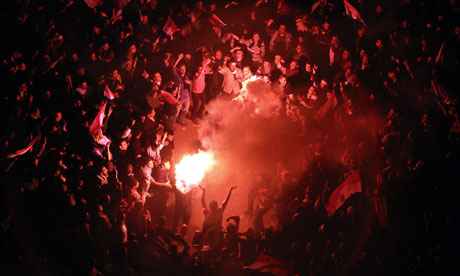![]()
Tahrir Square aflame: the visual basis of an imaginary revolution
Ten months ago, images from Egypt's streets such as these led many to succumb to a secular liberal fantasy

Egyptian anti-government protesters celebrate minutes after the announcement of the resignation of President Hosni Mubarak in February. Photograph: Khaled Elfiqi/EPA
This photograph is a human volcano. A heart of fire unites a crowd that seems to dance in the fire and flame of victory. At the vortex of the tumult, a bright flare of joy explodes. It looks as if the passions of the people were spontaneously producing this eruption of light and heat.
But what do light and heat really mean, in the making of history? Is the visible brightness of great events an illumination, or a distraction? The scene in this picture thrilled the world early this year. It is Tahrir Square celebrating after the resignation of President Hosni Mubarak in February, after mass protests and failed attempts to suppress them. Egypt's revolution lit up the Arab spring. It captured imaginations and shattered assumptions. It rekindled the idea of revolution in a way scarcely felt since John Reed wrote his account of the 1917 Russian revolution, Ten Days that Shook the World.
How does this image look in the wake of Egypt's recent elections? The French Annales school of historians, led by the medievalist Marc Bloch and the economic historian Fernand Braudel, were suspicious of spectacular events. They came from a country that has long argued over the meaning of its most mythic historical episode – the original modern revolution that began in 1789. According to the Annales historians, "events" do not matter very much in history. They are flashes of drama on the surface, florid sunspots. The true nuclear furnace of human development lies under the surface, invisible to the naked eye.
Deep and slow-moving social forces, from the material foundations of life to the mentalities of religious belief and cosmology, are what truly shape history in "the long term". In the long term, the events that drew all eyes to Egypt this year were just the inevitable outcome of a religious absorption of politics that began in the early 20th century. The Muslim Brotherhood's triumph in the first elections since the fall of Mubarak is a vindication for an organisation that has endured, at times, enormous persecution since it was founded in 1928.
The Brotherhood's Freedom and Justice party was widely expected to come out best in these elections – which are not yet complete – and it is fulfilling its hopes. What seems to have caught observers by surprise is the additional strength of the al-Nour party, representing Egypt's highly conservative Salafist religious movement that until this year was not seen as having political ambitions at all.
In run-offs for individual seats between the two religious parties, it looks like many voters opted for the moderate choice and the Muslim Brotherhood will emerge even stronger as a result. Yet the overall democratic balance revealed by these elections clearly leaves liberal secular politics looking marginalised. The victory belongs to political Islam – in whatever form will now evolve. Where does that leave the blazing image of Tahrir that this photograph preserves?
It leaves the Egyptian revolution looking like an "event" of the ephemeral and superficial type scorned by the Annales historians. Just as the revolutions of 1848 were mere pinpricks on the hide of the vast elephant of 19th-century industrial capitalism, so this year's changes in Egypt have culminated with the victory of slow, deep, long-term processes.
Tarek Osman's book Egypt on the Brink is a fascinating insight not least because it was published in 2010, just before the Arab spring, and so was not shaped by its excitement. (There is a new edition, but let's stick with the original version specifically to avoid the revisions of hindsight.) Osman offers many examples and statistics illustrating the religious transformation of Egyptian culture – which was once seen as cosmopolitan, liberal and glamorous – in the later 20th century. Wearing the veil had been a minority choice in Egypt: by the early 1990s it was "established as the dress code on the Egyptian street". In the mid-1980s there was one mosque for every 6,031 Egyptians; by the mid-2000s this had risen to one mosque for every 745 Egyptians.
The Muslim Brotherhood has a long history but its road to power was chosen in the wake of savage terrorism and equally savage repression in the 1980s and 1990s. The violence of the Mubarak regime in suppressing Islamist terrorism is now part of the history of its injustices, but it is worth remembering how violent the terrorism actually was, as recently as 1997, when an attack at the temple of Luxor killed 58 visitors and four Egyptians. The Muslim Brotherhood distanced itself from these groups and became an increasingly pro-democratic movement, making it the justified as well as inevitable victor in the current elections.
But its political party is just one facet of a much wider and deeper influence. Religion is a special force in human affairs because it takes the whole of life as its theme. Islamists are concerned not with the petty and superficial trivia of day-to-day politics but with every aspect of life, from how women dress to the deepest realities of death, sickness and poverty. It is the profound revival of religion in the Islamic world that remains the great force in the entire region, and the Arab spring was never going to change that.
Where does that leave this photograph of a revolution that inspired enthusiasm around the world? It depends what you saw in the picture to begin with. It seems to me that much reporting of, and enthusiastic commentary on, the revolution in Egypt and its defining images of Tahrir Square has ignored underlying realties that were not so hard to discover. Why has the Salafist strength in these elections come as a surprise? Because images like this one have become the basis of an imaginary revolution, a secular liberal fantasy. A fiery event cannot erase the deep forces that shape the hearts of nations.



